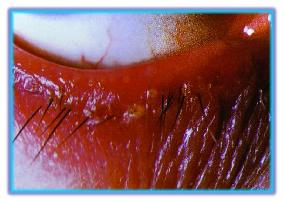| Acute or Chronic
staphylococcal blepharitis is usually caused by
Staphylococus aureus, but it can also be caused by
coagulase-negative staphylococci, and occasionally other
bacteria. These bacteria infect the lid margin, the lash
bases and follicles, and the associated glands. The resultant lid inflammation
causes burning, foreign-body sensation, redness and
mattering of the lashes. Examinatin reveals lid margin
erythema and ulceration, fibrin, collarettes, and crusts
at the base of the lashes. The condition can also be
associated with recurrent hordeola conjunctivitis, and
marginal corneal infiltrates. A coarse punctate
epitheliopathy can involve the inferior third of the
cornea. In cases of long-standing disease, the thickend
and scarred lids can produce contour abnormalities as
well as lost or misdirected lashes.
Treatment of
staphylococcal blepharitis is directed at eradicating the
offending organism. Intensive lid hygiene can be
effective. Hot soaks increase local vasuclar flow and
help to loosen the attached debris. Lid scrubs with a
dilute non-irritating shampoo remove the irritating
scales and debris and eliminate some bacteria.
A bactericidal antibiotic
ointment applied to the lid margins can further decrease
the bacterial population. In patients with symptomatic
keratoconjunctivitis, limited and closely monitored use
of topical cortiosteroids may be necessary in the initial
treatment of the disease.
|
 |

